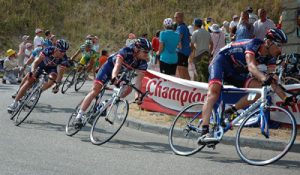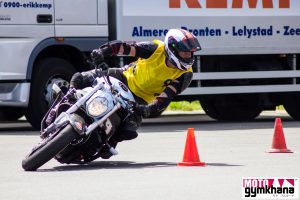What visual information does a cyclist use to make a turn? To answer this question, we need to know not only what kind of visual information the cyclist uses, but also what he is looking at before and during the turn. To get an idea of this, it is useful to study the viewing behavior of professional cyclists and motorcyclists. These professionals go through a turn much more quickly than ordinary mortals, and their bicycle therefore tilts much more. For us that is a good thing, because in such an extreme situation their viewing behavior is much more striking. Now take a look at the bottom series of images, and you immediately see that these professionals are all looking inside the corner.




In the picture on the right you see images of two possible gaze directions during a turn to the left. The route is marked with a thick black line, the direction of travel with a black arrow, and the gaze direction with a red arrow. (The direction of travel is the direction you would ride if you were to continue straight ahead from there.) In the left image the gaze direction is to the left of the direction of travel, and this is called “looking through the curve”. And in the right image the gaze direction is to the right of the direction of travel, and this is called “looking out of the corner”. The angle between the gaze direction and the direction of travel determines the location on the future trajectory that you (as a cyclist) are currently looking at. Each position on the future trajectory is a so-called “movement target”, a scientific term that we will also use here. The sharper you look through the turn (the more left at a turn to the left, and the more right at a turn to the right), the farther the movement target is removed from your current position. If you look out of the corner (the right-hand image, looking in the extension of the bicycle), then you look at a location that is not on your future trajectory. In other words, you look at a location that is not a movement target. Professionals always look at a movement target.
Scientists distinguish four different reasons for looking at a movement goal:
- Obtain reliable directional information from the optic flow
- Avoid optokinetic nystagmus
- Obtain reliable directional information from the motion parallax
- Allow for motor preparation
We will now discuss these four reasons one by one. The first three reasons have to do with perception and the fourth one with movement.
1. Obtain reliable directional information from the optic flow
Optic flow concerns the speed and direction with which the environment moves past us, and in the video below this is illustrated with a point cloud.
Optic flow is useful in determining the direction of travel, and that is well illustrated when you play the above video fullscreen and looks at the center of your screen. This gives you the feeling to move in the direction of the center of your screen. This is because the points move faster as they are further away from the center of the screen; the points in the middle of the screen are almost stationary. Instead of looking at the center of the screen, you can also look next to the center, and that still gives you the feeling that you are moving in the direction of the center of your screen. Only, you do not feel so sure about your direction anymore, and that is because the location of the stationary points is not observed accurately anymore. After all, the center of the screen (the target of motion, the place where you move) is now in your peripheral field of view, and that is perceived less accurately than the central (foveal) field of view. The difference between the peripheral and the central field of view is well explained in the video below:
So, if you look away from your movement target, this goal is in your peripheral field of view, which is perceived less accurately than your central field of view. Therefore, it is also more difficult to steer accurately while you are looking away from your movement target.
2. Avoid optokinetic nystagmus
As you look away from a movement target, the environment moves faster over the center of your visual field (the fovea). Looking away from a movement target happens when you look out of the corner, and you get the corresponding visual experience if you watch right or left of the middle in the above optic flow video. Now, moving points and lines across the center of your field of vision create a disturbing eye movement reflex, the optokinetic nystagmus (OKN). The OKN is an involuntary movement of our eyes that is provoked by the movement before our eyes. This is nicely illustrated in the video below. This disturbing eye movement reflex can be avoided by looking in the direction of a movement target.
3. Obtain reliable directional information from the motion parallax
When we move around in space, nearby objects move faster over our retinas than objects further away. This phenomenon is called movement parallax, and it gives us information about the direction in which we move. In the video below the movement parallax is explained in a simple way. Note, the movement in the video is from the perspective of a person moving sideways (with a viewing direction that is 90 degrees different from the direction of travel), and that is almost never the case when steering through a turn. On a bicycle, the viewing direction rarely differs by more than 45 degrees from the direction of travel. Motion parallax is, however, independent of the angle between the viewing direction and the direction of travel; it occurs at every angle between 0 to 90 degrees.
The way in which our brain obtains reliable directional information from the movement parallax is essentially the same as with optic flow. Imagine that you ride your bike through a forest. The nearby trees move faster than the trees further away. From this you obtain information about your direction of travel, but if you want to accurately observe your direction of travel in relation to your movement target, then you have to look in the direction of your movement target. For example, in the above video you will not get reliable information about your direction of travel in relation to your movement target. After all, you look away from that movement target. If, on the other hand, you were moving in the direction of the horizon, the relative speed of movement of dog, chalet and trees would give you reliable information about your direction of travel in relation to your movement target.
4. Allow for motor preparation
If you look out of the corner, your future trajectory is in your peripheral visual field. That is why it is difficult to determine where your target is exactly, and that is all the more the case as that movement target is farther away from you. If you know exactly where your target is, you can prepare your movements (steering impulses and weight displacements), and thanks to this preparation you can steer faster and more accurately at the moment you have to change direction. We discuss the details of this process on a separate page. First we discuss three ways of looking through the turn.